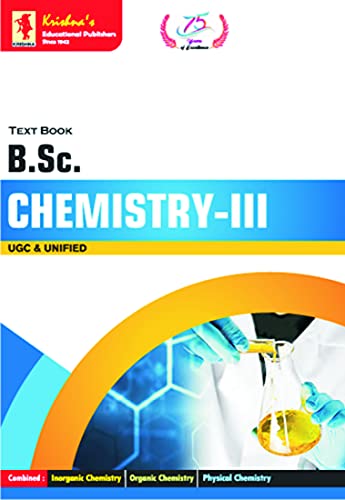
English | 2021 | ASIN: B097TKFYK5 | 987 pages | PDF | 11 MB
SYLLABUS- B.Sc. CHEMISTRY-III,
INORGANIC CHEMISTRY-III
B.Sc. III Year Paper-I
UNIT-I
I. Metal-ligand bonding in Transition Metal Complexes: Limitations of valance bond
theory, an elementary idea of crystal field theory, crystal field splitting in octahedral,
tetrahedral and square planner complexes, factors affecting the crystal-field parameters.
II. Thermodynamic and Kinetic Aspects of Metal Complexes: A brief outline of
thermodynamics stability of metal complexes and factors affecting the stability, stability
constants of complexes and their determination, substitution reactions of square planar
complexes.
UNIT-II
III. Magnetic Properties of Transition Metal Complexes: Types of magnetic behavior,
methods of determining magnetic susceptibility, spin-only formula, L-S coupling, correlation
of ms and meff values, orbital contribution to magnetic moments, application of magnetic
moment data for 3d-metal complexes.
IV. Electronic spectra of Transition Metal Complexes: Types of electronic transitions,
selection rules for d-d transitions, spectroscopic ground states, spectrochemical series, Orgel-
energy level diagram for d1 and d9 states, discussion of the electronic spectrum of
[Ti(H2O) 6] 3+ complex ion.
UNIT-III
V. Organometallic Chemistry: Definition, nomenclature and classification of
organometallic compounds, Preparation, properties, bonding and applications of alkyls and
aryls of Li, Al, Hg, Snl. Metal carbonyls: 18 electron rule, preparation, structure and nature of
bonding in the mononuclear carbonyls.
VI. Silicones and Phosphazenes: Silicones and phosphazenes as examples of inorganic
polymers, nature of bonding in triphosphazenes.
UNIT-IV
VII. Hard and Soft Acids and Bases (HSAB): Classification of acids and bases as hard and
soft,
ORGANIC CHEMISTRY-III
B.Sc. III Year Paper-II
PHYSICAL CHEMISTRY-III
B.Sc. III Year Paper-III
UNIT-I
(Introductory Quantum Mechanics, Spectroscopy, Physical Properties and Molecular
Structure)
I. Introductory Quantum Mechanics: Black-body radiation, Planck's radiation law,
photoelectric effect, heat capacity of solids, Bohr's model of hydrogen atom (without
derivation) their solution of overall solution and its defects, Compton effect, de-Broglie's
hypothesis, the Heisenberg's uncertainty principle, Hamiltonian Operator.
II. Spectroscopy: Introduction: electromagnetic radiation, regions of the spectrum, basic
features of different spectrophotometers, statement of the born-oppenheimer approximation,
degrees of freedom.
UNIT-II
IV. Elementary Quantum Mechanics: Schrödinger wave equation and its importance,
physical interpretation of the wave function, postulates of quantum mechanics, particle in a
one dimensional box.
UNIT-IV
(Photochemistry, Solutions, Dilute Solutions and Colligative Properties)
VI. Photochemistry: Interaction of radiation with matter, difference between thermal and
photochemical processes, Laws of photochemistry: Grothus-Drapper law, Stark-Einstein law,
Jablonski diagram depicting various processes occurring in the excited state, qualitative
description of fluorescence, phosphorescence, non-radiative processes (internal conversion,
intersystem crossing), quantum yield, photosensitized reactions energy transfer processes
(simple examples), Kinetics of Photo chemical reaction.
download скачать
https://nitroflare.com/view/DBD6AE7F1BD5501/m7aia.Krishnas..B.Sc..Chemistry.III.Edition3B.pdf
https://rapidgator.net/file/58624458a9bd3300849974e37bb96eec/m7aia.Krishnas..B.Sc..Chemistry.III.Edition3B.pdf

